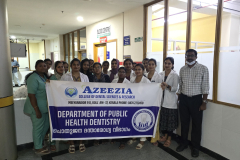REPORT OF FIELD VISIT TO BLOOD BANK
As a part of World Blood Donor’s Day (14.06.25), Department of Public Health Dentistry and Azeezia College of Dental Sciences and Research and NSS unit (NSS/SFU/KLM/KUHS/3) organized a visit to Blood Bank, Azeezia Medical College on 13.06.25 to gain practical exposure to the blood donation and storage processes. The visit was aimed at enhancing our awareness about safe blood donation and critical role of blood bank in saving lives.
We, the Final year part A BDS students along with Dr Naveen Jacob Varghese, Senior Lecturer, Department of Public Health Dentistry, Azeezia College of Dental science and research institute, along with interns visited blood bank. We were guided by two of the faculties of blood bank, who gave us information about blood collection and storage and showed us each of the rooms where the procedures were done.
We first visited the donor’s room where the donation process was taking place. In the donor’s room, a voluntary donor was in the process of donating blood. Meanwhile, the faculties explained the donation process. Before donation, every individual undergoes a screening process which includes donor form filling and checking vital signs. There are some instances when blood can’t be donated which includes abnormal blood pressure, if the donor is diabetic, donor having any hormonal imbalance (hypo/hyperthyroidism), donor under medication, menstruating and pregnant women also can’t donate. Blood was collected in 3 collection bags(single, double, triple) containing anticoagulant depending on the donor’s body weight. For donor weighing more than 45kg, a 350 ml bag is used and a donor weighing more than 55 kg, a 450 ml bag is used. The anticoagulant used in single and double bag is CPOA(citrate phosphate dextrose adenine). In the triple bag, the anticoagulants are CPOA and SAGM(saline adenine glucose mannitol). A single bag is used for collecting the whole blood only. Double bag allows collection and separation of whole blood into 2 components PRBC(packed red blood cells). Triple bag enables separation of whole blood into 3 components, which includes PRBC, FFP(fresh frozen plasma) and platelets. They also explained about the life span of each, i.e, for blood collected, it is 35-42 days, for platelets it is 5 days and plasma, it is about one year.
In the component separation area, we saw how the collected whole blood is separated into useful components using a centrifuge machine. The separated components are handled in a sterile environment. We also observed a laminar air flow cabinet which ensures sterile conditions while processing blood components and platelet agitated which keeps platelets in constant motion to maintain viability and prevent clumping.
The storage room contains processed blood in which untested blood and tested blood are stored separately. The untested blood which is collected from the donor is immediately placed in a separate freezer of 2-4 ℃ until it gets tested. Then it is kept along with the tested blood. A deep freezer of – 40 ℃and -80℃ for the storage of FFP was also shown. In the crossmatching area, the compatibility test between donor and recipient is tested. There are two types of crossmatching; those are major and minor. Major cross match done using recipient serum and donor’s RBCs. While minor is done using donor’s serum and recipient’s cells. This is done to avoid transfusion reaction. Cross matching is done in matrix gel card.
TTI(transfusion transmitted infections) testing area where each collected unit is made to undergo strict screening for HIV,Hepatitis B&C,syphilis and group test. Only TTI negative units are approved for transfusions. ELISA is done for HIV and syphilis manually in the blood bank except mixings of blood.When the test is positive, first inform the patient and give counselling regarding the associated disease. After this, his/her blood is discarded by autoclaving first and later passed on to IMAGE.
This blood bank visit conducted on the occasion of World Blood donor day provided us with deep insight into the journey of blood from donor to recipient. It emphasized the importance of voluntary blood donation, the strict safety measure followed in handling blood, and the scientific methods used to separate, store and test blood components. We are now more aware and inspired to advocate for regular and safe blood donation.









